An Insightful Overview of Coworking Digested

Sometimes there are academic papers that strike all the right notes being informative, insightful, & accessible to the non-learnèd. When I came across “Coworking: A Transdisciplinary Overview” I was pleased indeed to have found a paper that has a particularly satisfying resonance for anyone interested in the emerging global trend of #coworking. Alongside the Deskmag / Coworkaholic “2016 Coworking Outlook” report, it’s clear to see how working trends are changing and where they moving to over the coming years.
Sometimes there are academic papers that strike all the right notes being informative, insightful, & accessible to the non-learnèd. When I came across “Coworking: A Transdisciplinary Overview” I was pleased indeed to have found a paper that has a particularly satisfying resonance for anyone interested in the emerging global trend of #coworking. Alongside the Deskmag / Coworkaholic “2016 Coworking Outlook” report, it’s clear to see how working trends are changing and where they moving to over the coming years.
However, for those who want to understand more about coworking and would rather not go through a 58 page academic paper I thought I draw out a few of the key points from this great (but rather dryly named) paper by 5 Australian academics.
An Overview — Adaptation & Innovation
As to be expected thing are kicked in to play with a theoretical overview of how the way we work has changed through #globalisation & #technological change. Essentially the point being that the relationship between our geographic location & socio-economic activities have changed fundamentally: mobile, flexible work in creative, tech & other sectors are now rather established.
This process of change has seen adaptation & innovation in both how & where we work as well as some interesting development in cooperation & collectivism. One of the biggest steps forward applied to a spatial concept for work, learning & recreation has been with the development of coworking: “shared physical workspaces that often have elements of cooperation between independent workers”.
Coworking, Coworking Spaces & Third Places
So what’s the difference right? Well, at the core of it a coworking space is pretty much an open plan office shared by mobile & independent workers. However, coworking is more complex as it’s more than simply access to spaces and facilities. There is an interesting and elusive quality to this phenomena of:
‘working-alone-together’
This is shared in part with other related spaces the authors define as third places* — places between home (‘first place’) & primary workplace (‘second’ place). Third places are where formal productive activities take place alongside informal social interactions and learning (whether explicit or undirected). The diagram below is useful if you’ve ever wanted to understand what the difference between #incubators, #accelerators, serviced offices, #hacker space & coworking are, noting the work / learn / play axis:
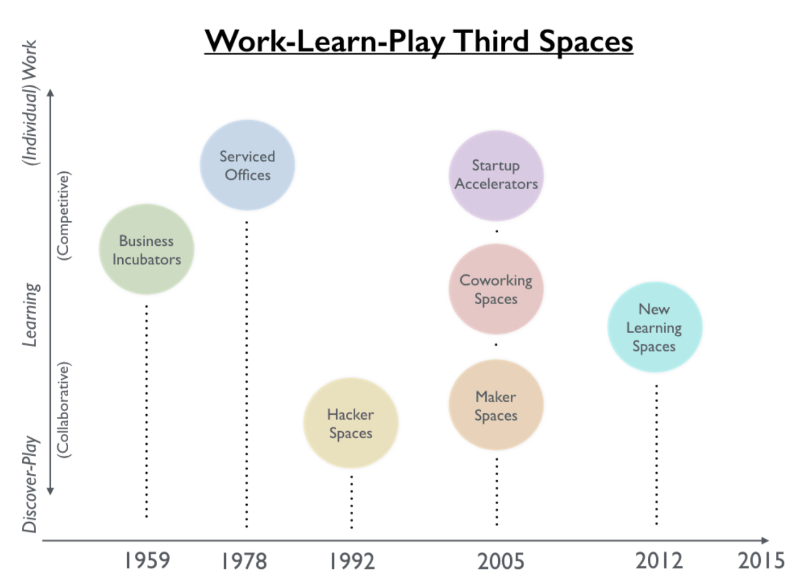
The timeline is also interesting in showing the acceleration of the establishing of new kinds of productive spaces.
Serviced Offices & Coworking Spaces
This is an area that has been of particular interest to us when we’ve needed to define who our booking and space management platform is for and how it meets the specific needs of the market. For example, if a coworking space is essentially an open plan office shared by mobile and independent workers how does this differ from the more established industry of ‘serviced offices’?
Essentially, serviced offices are based on:
“a business model based on flexible, low commitment rental access to office space and amenities. A combination of services are usually ‘bundled’ together in exchange for a single, all inclusive fee”
Think Regus for the most obvious example.
The business model isn’t radically different for coworking hubs where coworkers pay a flexible, and usually all inclusive monthly fee for their membership. But there are some key difference such as:
a) the profile of coworkers: “coworking was established both by and for the ‘creatives’ and serviced offices predominantly designed for the ‘suits’”
b) an accent on social interactions: “the coworking movement has distinguished itself from the serviced office industry by emphasising the social interactions of its participants as a core feature of its value proposition …promot[ing] themselves as a ‘membership community’”
c) the aesthetics and design of the space themselves: think “a google style office for people that don’t work at google”. If you’ve ever been to a coworking hub, you’ll know that design occupies a large (and occasionally very silly!) role.
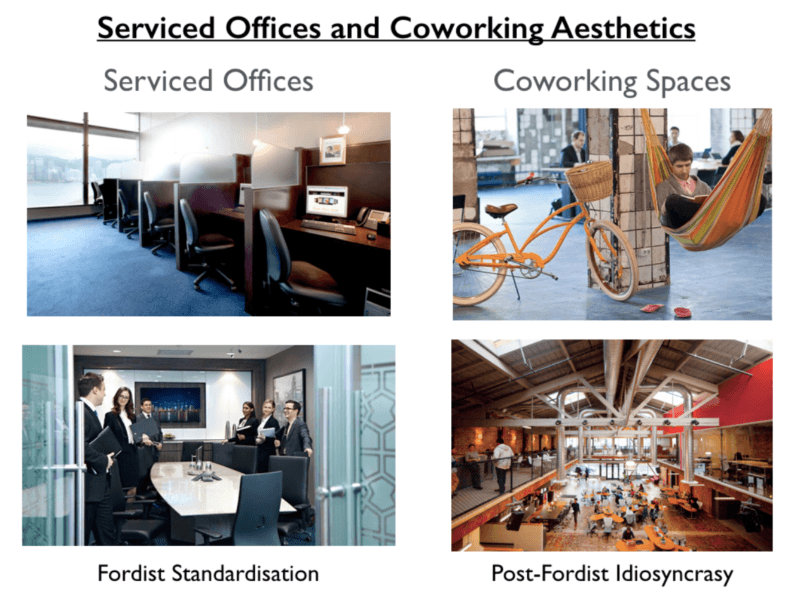
However, as time has progressed, the lines between serviced offices and coworking spaces have become more blurred. For example Regus & Servcorp claim to offer coworking, whilst WeWork and Next Space offer standardised offices, resulting in the following:
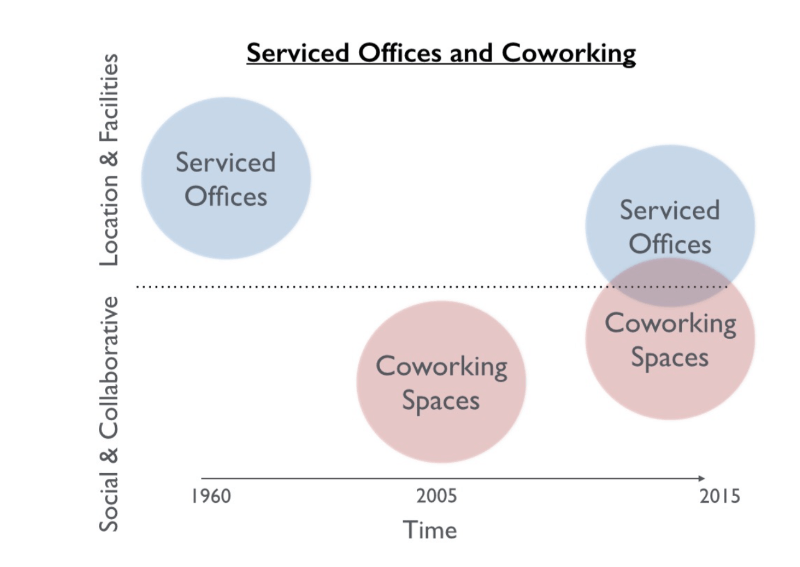
One of the major goals for coworking spaces are to “combine the best parts of an office environment- community, collaboration and access to the right tools — with the benefits of working at home or working for yourself — convenience, flexibility, autonomy.”
One last slightly technical distinction I enjoyed was the notion that “serviced offices are shared goods that are prone to anonymous crowding, coworking spaces are prone to non-anonymous crowding”
The Coworking Revolution & Global Growth
The growth of coworking spaces since 2005 has been exponential and looks to continue that way. The following charts are particularly revealing on this front:
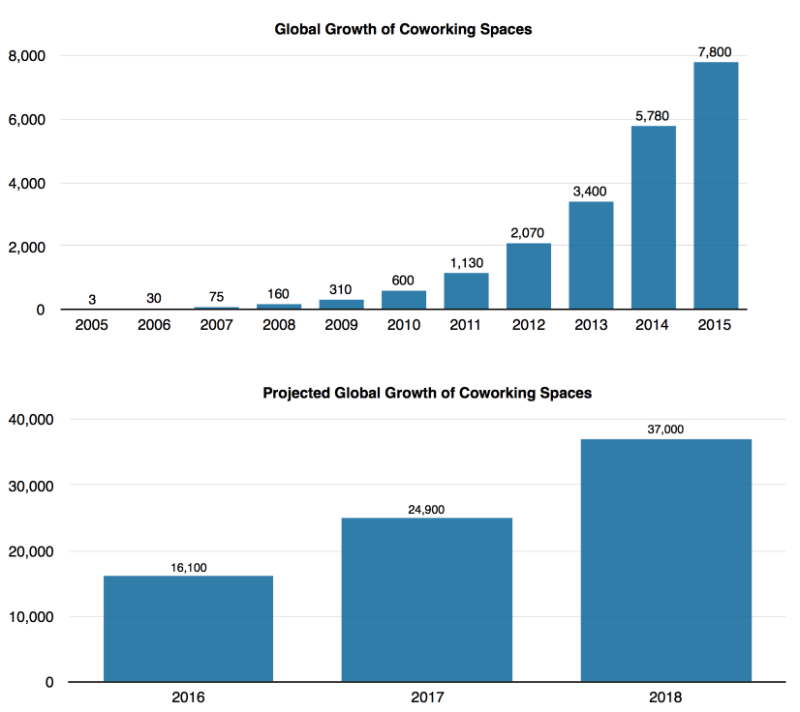
Though coworking began in the US & features heavily there as well as in the UK, it’s interesting to understand where coworking has taken root in across the planet. The diagrams below are intriguing in revealing Spain & Brazil as major epicentres of coworking particularly when we consider the different economic conditions in both countries. Coworking became a significant phenomena in Spain after the economic crash — indicating that traditional industries were failing & that adaptation, innovation & independence was critical for people to take control of their work-life. On the other hand Brazil has been developing into a major global economic powerhouse over the last decade or so. The fact that coworking has taken root there over the same period indicates that a healthy coworking ecosystem is a sign of a growing connected, global economy.
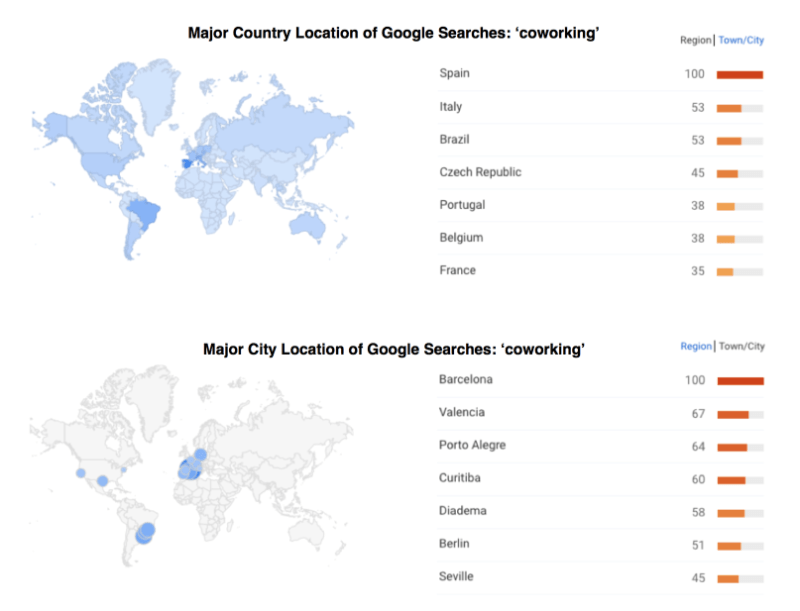
A couple of facts to note as to why coworking will continue to grow is based on the understanding of who it is that works in these kinds of spaces: freelancers, self-employed, & entrepreneurs. In the UK there are 4.5 million self-employed people — a figure that is continuing to rise. And “in Australia, recent estimates put the number of self employed at 18% of the workforce, with 900,000 solo self-employed and 1 million ‘self-employed employers’”.
There are a whole host of other insights and facts in “Coworking: A Transdisciplinary Overview” which I’d recommend you to check out if you’re keen.
We wholeheartedly appreciate the work that goes into making sense of the shifting flexible work/space environment and the networks that facilitate and strengthen this movement, so we send our thanks to the authors: Jason Potts, Tim Butcher, Julian M Waters-Lynch, Jago Dodson & Joe Hurley!
Never miss a beat!
Want to see it in action?
Co-founder, designer, reader, philosopher & plant whisperer. He plays dad, husband & attacking midfield.



